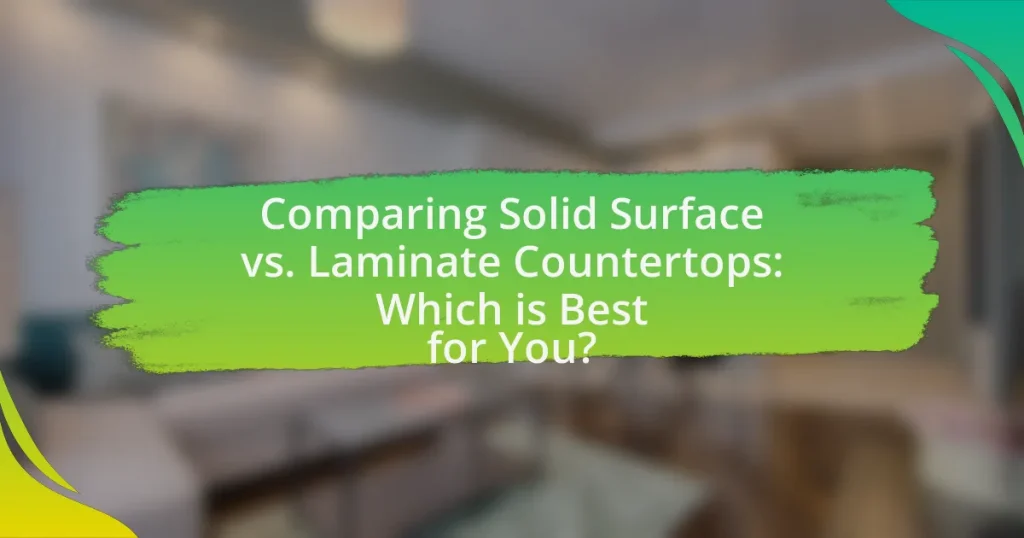Choosing the right material for kitchen countertops is essential for achieving durability, aesthetics, and functionality in kitchen design. This comprehensive guide covers critical factors to consider, including durability, maintenance, cost, heat resistance, and how different materials impact overall kitchen design. It explores popular materials such as granite, quartz, laminate, marble, and wood, detailing their unique characteristics, maintenance requirements, and suitability for various cooking habits. Additionally, the guide emphasizes the importance of aligning countertop choices with personal style and lifestyle needs, providing practical tips for evaluating options and avoiding common mistakes.
What Factors Should You Consider When Choosing Kitchen Countertop Materials?

When choosing kitchen countertop materials, consider durability, maintenance, aesthetics, cost, and heat resistance. Durability is crucial as countertops endure daily wear and tear; materials like granite and quartz are known for their strength. Maintenance requirements vary; for instance, laminate is low-maintenance, while natural stone may need sealing. Aesthetics play a significant role in design cohesion; select colors and patterns that complement your kitchen style. Cost is a practical factor; materials range from budget-friendly laminate to high-end marble. Lastly, heat resistance is important for cooking areas; materials like stainless steel can withstand high temperatures without damage.
How do different materials impact the overall kitchen design?
Different materials significantly influence the overall kitchen design by affecting aesthetics, functionality, and durability. For instance, natural stone countertops, such as granite or marble, provide a luxurious appearance and unique patterns, enhancing visual appeal. In contrast, laminate surfaces offer a more budget-friendly option with a wide range of colors and designs, allowing for versatile styling. Additionally, materials like stainless steel contribute to a modern, industrial look while being highly durable and easy to clean. The choice of material also impacts maintenance requirements; for example, wood countertops require regular sealing to prevent damage, while quartz surfaces are non-porous and resistant to staining. Ultimately, the selection of materials shapes the kitchen’s character, usability, and longevity, making it a crucial aspect of kitchen design.
What aesthetic qualities do various materials offer?
Various materials offer distinct aesthetic qualities that influence the overall look of kitchen countertops. For instance, granite provides a natural, luxurious appearance with unique patterns and colors, making each slab one-of-a-kind. Quartz, engineered from natural stone, offers a uniform look with a wide range of colors and finishes, appealing to modern design preferences. Marble is renowned for its elegant veining and classic beauty, often associated with high-end aesthetics. Laminate, while less expensive, can mimic the appearance of natural stone or wood, providing versatility in design. Lastly, concrete offers a contemporary, industrial feel that can be customized with stains and textures. Each material’s aesthetic qualities contribute significantly to the kitchen’s ambiance and style.
How do colors and patterns influence kitchen ambiance?
Colors and patterns significantly influence kitchen ambiance by affecting mood, perception of space, and overall aesthetic appeal. Warm colors like reds and yellows can create an inviting and energetic atmosphere, while cool colors such as blues and greens promote calmness and relaxation. Patterns, whether bold or subtle, can add visual interest and depth, making the kitchen feel more dynamic or cohesive. Research indicates that color psychology plays a crucial role in how individuals experience their environment, with studies showing that specific colors can evoke particular emotional responses. For instance, a study published in the Journal of Environmental Psychology highlights how color choices can impact feelings of comfort and satisfaction in home settings.
What are the practical considerations for countertop materials?
Practical considerations for countertop materials include durability, maintenance, cost, aesthetics, and heat resistance. Durability is crucial as countertops must withstand daily wear and tear; materials like granite and quartz are known for their strength. Maintenance varies by material; for instance, wood requires regular sealing, while laminate is low-maintenance. Cost is a significant factor, with options ranging from budget-friendly laminate to high-end marble. Aesthetics play a role in design choices, as colors and patterns can enhance kitchen appeal. Lastly, heat resistance is important for cooking areas; materials like stainless steel can tolerate high temperatures without damage.
How do durability and maintenance requirements vary among materials?
Durability and maintenance requirements vary significantly among materials used for kitchen countertops. For instance, granite is highly durable and resistant to scratches and heat, requiring minimal maintenance, typically just periodic sealing to prevent staining. In contrast, laminate is less durable, prone to scratches and burns, and requires more frequent replacement or repair, along with regular cleaning to maintain its appearance. Similarly, quartz offers a balance of durability and low maintenance, needing only soap and water for cleaning, while wood countertops, although aesthetically pleasing, require regular oiling and are more susceptible to damage from moisture and heat. These differences highlight the importance of selecting a material that aligns with both durability expectations and maintenance capabilities.
What is the cost range for different countertop materials?
The cost range for different countertop materials typically varies from $10 to $200 per square foot. For example, laminate countertops generally cost between $10 and $40 per square foot, while granite ranges from $40 to $100 per square foot. Quartz countertops usually fall within the $50 to $150 per square foot range, and high-end materials like marble can cost between $100 and $200 per square foot. These price ranges reflect the material quality, brand, and installation complexity, providing a comprehensive overview for those selecting kitchen countertops.
Why is it important to consider your cooking habits?
Considering your cooking habits is important because it directly influences the choice of materials for your kitchen countertops. Different cooking styles, such as frequent baking or meal prep, require surfaces that can withstand heat, moisture, and staining. For instance, if you often use hot pans, materials like granite or quartz are preferable due to their heat resistance. Additionally, if you frequently prepare acidic foods, a non-porous surface like quartz can prevent damage and staining. Understanding your cooking habits ensures that you select a countertop that meets your functional needs and enhances the longevity of your kitchen surfaces.
How do specific materials perform under heavy use?
Specific materials such as granite, quartz, and laminate exhibit varying performance levels under heavy use. Granite is highly durable and resistant to scratches and heat, making it ideal for high-traffic kitchens; studies show it can withstand heavy impacts without chipping. Quartz, engineered from natural stone and resin, offers similar durability but is less heat resistant than granite, with a heat tolerance of around 150 degrees Fahrenheit. Laminate, while cost-effective, is less durable and can scratch or warp under heavy use, particularly when exposed to moisture. Therefore, granite and quartz are preferable for heavy use, while laminate may require more frequent replacement or maintenance.
What materials are best for food preparation and hygiene?
Stainless steel, quartz, and glass are the best materials for food preparation and hygiene. Stainless steel is non-porous, easy to clean, and resistant to bacteria, making it ideal for food safety. Quartz surfaces are also non-porous and have antimicrobial properties, which help prevent the growth of harmful bacteria. Glass countertops are non-porous and can be easily sanitized, ensuring a hygienic food preparation area. These materials have been shown to maintain cleanliness and reduce the risk of foodborne illnesses, supporting their effectiveness in kitchen environments.
What Are the Most Popular Kitchen Countertop Materials?

The most popular kitchen countertop materials are granite, quartz, laminate, marble, and butcher block. Granite is favored for its durability and natural beauty, while quartz offers a non-porous surface that is easy to maintain. Laminate is a cost-effective option that comes in various designs, making it versatile. Marble is appreciated for its elegance but requires more maintenance due to its porous nature. Butcher block provides a warm, natural look and is ideal for food preparation. These materials are widely chosen based on their unique properties, aesthetics, and functionality in kitchen design.
What are the characteristics of granite countertops?
Granite countertops are known for their durability, aesthetic appeal, and low maintenance requirements. They are composed of natural stone, primarily made up of quartz, feldspar, and mica, which contributes to their strength and resistance to scratches and heat. Additionally, granite is available in a wide variety of colors and patterns, allowing for customization in kitchen design. The surface is non-porous when sealed properly, making it resistant to stains and bacteria, which enhances its suitability for food preparation areas. These characteristics make granite a popular choice among homeowners and designers alike.
How does granite compare to other materials in terms of durability?
Granite is one of the most durable materials available for countertops, often outperforming alternatives like laminate, marble, and quartz in terms of resistance to scratches, heat, and stains. Its hardness, rated at 6 to 7 on the Mohs scale, makes it highly resistant to physical damage, while its low porosity helps prevent staining when properly sealed. In contrast, laminate can easily scratch and is sensitive to heat, marble is softer and more prone to etching, and quartz, while durable, can be less heat-resistant than granite. These characteristics establish granite as a superior choice for durability in kitchen countertops.
What maintenance is required for granite countertops?
Granite countertops require regular sealing, cleaning with pH-balanced solutions, and avoiding harsh chemicals. Sealing should be done every 1 to 3 years to prevent staining and maintain the surface’s integrity. Cleaning with a mild soap and water solution helps preserve the finish without damaging the stone. Additionally, using coasters and cutting boards can prevent scratches and etching, ensuring the longevity of the countertops.
What advantages do quartz countertops offer?
Quartz countertops offer durability, low maintenance, and a wide range of aesthetic options. Their non-porous surface resists staining and bacterial growth, making them hygienic and easy to clean. Additionally, quartz is engineered to be highly resistant to scratches and heat, which enhances its longevity compared to other materials. The variety of colors and patterns available allows homeowners to achieve a customized look that fits their design preferences.
How does the non-porous nature of quartz benefit kitchen use?
The non-porous nature of quartz benefits kitchen use by preventing the absorption of liquids and bacteria. This characteristic ensures that spills do not penetrate the surface, making it easier to clean and maintain hygiene. Additionally, the non-porous quality reduces the risk of staining from common kitchen substances like oils, juices, and food coloring, which enhances the longevity and appearance of the countertop.
What design options are available with quartz countertops?
Quartz countertops offer a variety of design options, including a wide range of colors, patterns, and finishes. These countertops can mimic the appearance of natural stone, such as granite or marble, while providing a more uniform look. Additionally, quartz surfaces can be customized with veining, speckles, or solid colors, allowing for personalized aesthetics. The finish options include polished, honed, or textured surfaces, catering to different design preferences and functional needs. This versatility makes quartz a popular choice for modern kitchen designs.
What makes wood countertops a unique choice?
Wood countertops are a unique choice due to their natural beauty, warmth, and versatility. Unlike synthetic materials, wood offers a distinct aesthetic that can enhance the overall design of a kitchen, providing a cozy and inviting atmosphere. Additionally, wood is a renewable resource, making it an environmentally friendly option compared to non-biodegradable materials. The ability to be sanded and refinished allows wood countertops to maintain their appearance over time, which is not possible with many other countertop materials. Furthermore, wood has natural antibacterial properties, contributing to a healthier kitchen environment.
How do wood countertops perform in terms of heat and scratches?
Wood countertops are generally not heat-resistant and can be prone to scratches. When exposed to high temperatures, such as hot pots or pans, wood can warp, crack, or discolor. Additionally, while wood surfaces can withstand some level of scratching, they are more susceptible to damage compared to materials like granite or quartz. Regular maintenance, such as oiling and refinishing, can help mitigate these issues, but wood countertops still require careful handling to maintain their appearance and integrity.
What are the best practices for maintaining wood countertops?
To maintain wood countertops effectively, regularly clean them with a mild soap and water solution, avoiding harsh chemicals that can damage the finish. Additionally, applying mineral oil or a food-safe wood conditioner every few months helps to prevent drying and cracking, preserving the wood’s appearance and durability. Research indicates that proper maintenance can extend the lifespan of wood countertops significantly, with regular oiling reducing the risk of water damage and warping.
How Can You Make the Best Choice for Your Kitchen Countertops?

To make the best choice for your kitchen countertops, evaluate materials based on durability, maintenance, aesthetics, and cost. For instance, granite offers high durability and a unique appearance but requires sealing, while quartz is non-porous and low-maintenance, making it a practical choice for busy kitchens. Additionally, consider your cooking habits and lifestyle; if you frequently entertain or cook, a more resilient surface may be necessary. Research indicates that 70% of homeowners prioritize durability and ease of cleaning when selecting countertops, highlighting the importance of these factors in decision-making.
What steps should you take to evaluate your options?
To evaluate your options for kitchen countertop materials, start by identifying your specific needs and preferences, such as durability, maintenance, aesthetics, and budget. Next, research various materials like granite, quartz, laminate, and marble to understand their characteristics and benefits. After gathering information, compare the pros and cons of each material based on your criteria. Finally, consult with professionals or visit showrooms to see samples in person, which will help you make an informed decision. This structured approach ensures that you consider all relevant factors before making a choice.
How can you assess your kitchen’s needs and style preferences?
To assess your kitchen’s needs and style preferences, start by evaluating your cooking habits, storage requirements, and the overall functionality you desire. Consider how often you cook, the types of meals you prepare, and whether you need additional storage solutions. Next, identify your aesthetic preferences by exploring various design styles, such as modern, traditional, or rustic, and gather inspiration from magazines, websites, or showrooms. This approach allows you to align your kitchen’s functionality with your personal style, ensuring that the materials you choose for countertops complement both your practical needs and visual preferences.
What role does budget play in your decision-making process?
Budget plays a critical role in the decision-making process for selecting kitchen countertop materials. It directly influences the range of materials considered, as different options come with varying price points. For instance, natural stones like granite and marble typically cost more than laminate or butcher block options. A well-defined budget helps prioritize features and aesthetics while ensuring that the chosen material aligns with financial constraints. According to a survey by the National Kitchen and Bath Association, 35% of homeowners cite budget as the primary factor in their material selection, underscoring its significance in the decision-making process.
What are some common mistakes to avoid when selecting countertop materials?
Common mistakes to avoid when selecting countertop materials include not considering durability, overlooking maintenance requirements, and failing to match the material with the kitchen’s overall design. Durability is crucial; for instance, materials like granite and quartz are more resistant to scratches and heat compared to softer options like laminate. Maintenance is another key factor; some materials require regular sealing or special cleaning products, which can be time-consuming and costly. Additionally, selecting a countertop that clashes with the kitchen’s aesthetic can detract from the overall design; for example, a modern kitchen may not suit a rustic wood countertop. These considerations are essential for ensuring a functional and visually appealing kitchen space.
How can you ensure you choose a material that fits your lifestyle?
To ensure you choose a material that fits your lifestyle, assess your daily activities and maintenance preferences. For example, if you frequently cook and entertain, select a durable and easy-to-clean material like quartz or granite, which can withstand heat and stains. Research indicates that quartz countertops are non-porous, making them resistant to bacteria and easy to maintain, aligning well with a busy lifestyle. Additionally, consider factors such as aesthetic preferences and budget constraints, as these will influence your final decision.
What should you consider regarding installation and long-term use?
When considering installation and long-term use of kitchen countertops, it is essential to evaluate the material’s durability, maintenance requirements, and resistance to stains and heat. Durable materials, such as granite or quartz, can withstand daily wear and tear, while options like laminate may require more frequent replacement. Maintenance is crucial; some materials need regular sealing or special cleaning products to maintain their appearance and functionality. Additionally, understanding the heat resistance of the chosen material is vital, as some surfaces can be damaged by hot pots or pans. For instance, granite can tolerate high temperatures, whereas laminate may warp or discolor.
What tips can help you finalize your countertop choice?
To finalize your countertop choice, consider your lifestyle, budget, and aesthetic preferences. Assess how often you cook and entertain, as materials like granite or quartz are durable and resistant to stains, making them suitable for heavy use. Evaluate your budget, as options range from affordable laminate to high-end marble, which can significantly impact your decision. Additionally, visualize how each material complements your kitchen’s design; samples can help you see how colors and textures work together. Research shows that 70% of homeowners prioritize durability and maintenance when selecting countertops, indicating the importance of these factors in the decision-making process.
How can you effectively compare samples and finishes?
To effectively compare samples and finishes, utilize a systematic approach that includes visual inspection, tactile evaluation, and performance testing. Begin by examining the samples under consistent lighting to assess color and texture accurately. Next, physically touch each finish to evaluate its feel, durability, and resistance to scratches or stains. Additionally, conduct performance tests, such as water resistance and heat tolerance, to determine how each material will hold up in a kitchen environment. This methodical comparison ensures informed decisions based on both aesthetic and functional criteria.
What resources are available for making an informed decision?
Resources available for making an informed decision about kitchen countertop materials include online guides, product reviews, and expert consultations. Online guides provide detailed comparisons of materials such as granite, quartz, and laminate, highlighting their pros and cons. Product reviews from consumers offer insights into durability and maintenance, while expert consultations can provide personalized advice based on specific kitchen needs. These resources collectively help homeowners evaluate options effectively, ensuring they choose the best material for their kitchen countertops.



